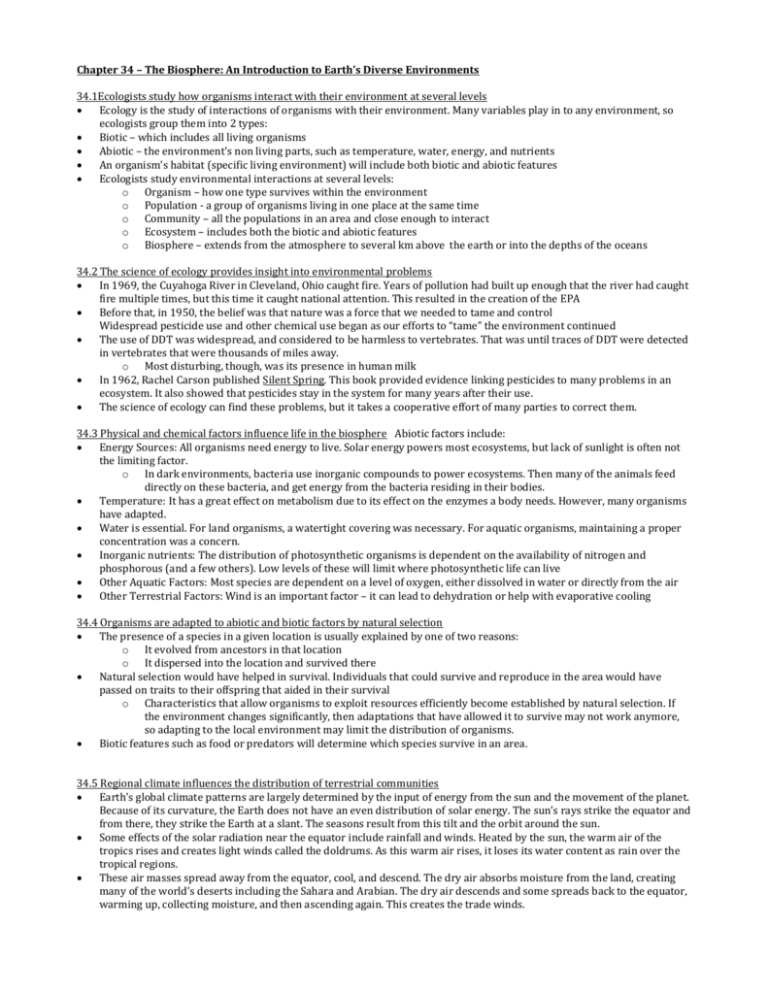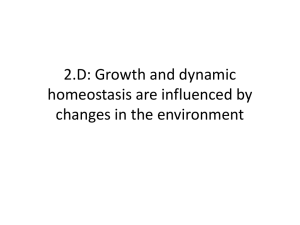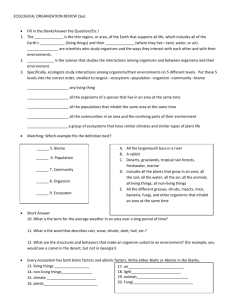Chapter 34 – The Biosphere: An Introduction to Earth`s Diverse
advertisement

Chapter 34 – The Biosphere: An Introduction to Earth’s Diverse Environments 34.1Ecologists study how organisms interact with their environment at several levels Ecology is the study of interactions of organisms with their environment. Many variables play in to any environment, so ecologists group them into 2 types: Biotic – which includes all living organisms Abiotic – the environment’s non living parts, such as temperature, water, energy, and nutrients An organism’s habitat (specific living environment) will include both biotic and abiotic features Ecologists study environmental interactions at several levels: o Organism – how one type survives within the environment o Population - a group of organisms living in one place at the same time o Community – all the populations in an area and close enough to interact o Ecosystem – includes both the biotic and abiotic features o Biosphere – extends from the atmosphere to several km above the earth or into the depths of the oceans 34.2 The science of ecology provides insight into environmental problems In 1969, the Cuyahoga River in Cleveland, Ohio caught fire. Years of pollution had built up enough that the river had caught fire multiple times, but this time it caught national attention. This resulted in the creation of the EPA Before that, in 1950, the belief was that nature was a force that we needed to tame and control Widespread pesticide use and other chemical use began as our efforts to “tame” the environment continued The use of DDT was widespread, and considered to be harmless to vertebrates. That was until traces of DDT were detected in vertebrates that were thousands of miles away. o Most disturbing, though, was its presence in human milk In 1962, Rachel Carson published Silent Spring. This book provided evidence linking pesticides to many problems in an ecosystem. It also showed that pesticides stay in the system for many years after their use. The science of ecology can find these problems, but it takes a cooperative effort of many parties to correct them. 34.3 Physical and chemical factors influence life in the biosphere Abiotic factors include: Energy Sources: All organisms need energy to live. Solar energy powers most ecosystems, but lack of sunlight is often not the limiting factor. o In dark environments, bacteria use inorganic compounds to power ecosystems. Then many of the animals feed directly on these bacteria, and get energy from the bacteria residing in their bodies. Temperature: It has a great effect on metabolism due to its effect on the enzymes a body needs. However, many organisms have adapted. Water is essential. For land organisms, a watertight covering was necessary. For aquatic organisms, maintaining a proper concentration was a concern. Inorganic nutrients: The distribution of photosynthetic organisms is dependent on the availability of nitrogen and phosphorous (and a few others). Low levels of these will limit where photosynthetic life can live Other Aquatic Factors: Most species are dependent on a level of oxygen, either dissolved in water or directly from the air Other Terrestrial Factors: Wind is an important factor – it can lead to dehydration or help with evaporative cooling 34.4 Organisms are adapted to abiotic and biotic factors by natural selection The presence of a species in a given location is usually explained by one of two reasons: o It evolved from ancestors in that location o It dispersed into the location and survived there Natural selection would have helped in survival. Individuals that could survive and reproduce in the area would have passed on traits to their offspring that aided in their survival o Characteristics that allow organisms to exploit resources efficiently become established by natural selection. If the environment changes significantly, then adaptations that have allowed it to survive may not work anymore, so adapting to the local environment may limit the distribution of organisms. Biotic features such as food or predators will determine which species survive in an area. 34.5 Regional climate influences the distribution of terrestrial communities Earth’s global climate patterns are largely determined by the input of energy from the sun and the movement of the planet. Because of its curvature, the Earth does not have an even distribution of solar energy. The sun’s rays strike the equator and from there, they strike the Earth at a slant. The seasons result from this tilt and the orbit around the sun. Some effects of the solar radiation near the equator include rainfall and winds. Heated by the sun, the warm air of the tropics rises and creates light winds called the doldrums. As this warm air rises, it loses its water content as rain over the tropical regions. These air masses spread away from the equator, cool, and descend. The dry air absorbs moisture from the land, creating many of the world’s deserts including the Sahara and Arabian. The dry air descends and some spreads back to the equator, warming up, collecting moisture, and then ascending again. This creates the trade winds. Prevailing winds result from combined rising and falling of air masses and the earth’s rotation. The earth is a sphere, and winds move faster at the equator than at other latitudes. In temperate zones, slower moving surface air makes westerlies. In combination with the prevailing winds, the planet’s rotation, unequal heating of the surface water, and continent shape, ocean currents are created in a pattern in the ocean. Climate and other abiotic features of the environment affect the distribution of organisms creating biomes. Biomes are ecological associations occupying large areas of land or water. 34.6 Sunlight and substrate are key factors in the distribution of marine organisms Depending on many things, marine ecosystems are extremely diverse: o Deep oceans have no sunlight, while coral reefs are totally dependent on it o Shore habitats differ from mid-ocean, each hosting different communities Pelagic realm is considered open ocean Benthic realm is the sea floor Photic zone marks the deepest place that light penetrates Continental shelves are the submerged parts of the continent above In sunlit regions, phytoplankton provides energy and carbon for the animals Zooplankton are small drifting animals that serve as food for higher organisms Coral reefs are in the photic zones and sit on the continental shelves of warm tropical waters. They are built on the remains of cnidarians, that secrete a hard exoskeleton, and unicellular algae encrusted with limestone. They support a wide variety of other life, including fish and invertebrates. Below the photic zone is the aphotic zone. There is not enough light for photosynthesis, and many organisms will migrate upwards at night to feed. Organisms in this zone may have adaptations (large eyes or unique features) that allow them to feed. Intertidal Zones: Where the ocean interfaces with land. This is home to many sessile organisms, such as algae barnacles or mussels. Attachment to rocks keeps them from being washed away. On beaches, animals burrow into the sand. This includes suspension-feeding worms, clams, or predatory crustaceans. Estuary: Where a freshwater body merges with the ocean. Waters are enriched by nutrients from the ocean, and the salinity varies from ocean levels to that of the freshwater. This is one of the most productive biomes on earth. They can be home to oysters, crabs, and fish. Both fish and water fowl use these as reproductive/nesting sites Wetlands: Transitional biome between an aquatic area and a terrestrial area. It can be either freshwater or marine. They may be covered with water permanently or periodically. This water coverage supports the growth of aquatic plants 34.7 Current, Sunlight, and nutrients are important abiotic factors in freshwater biomes Freshwater biomes cover less than 1% of Earth’s surface, but only contain 0.01% of its water. Yet they harbor 6% or all biodiversity We depend on freshwater for drinking, irrigation, sanitation, and industry They fall into 2 categories: o Standing water, like lakes and ponds o Flowing water, like rivers and streams Lakes and Ponds: The communities are distributed based on depth of water and distance from shore. Phytoplankton and rooted plants will grow in the shallows close to shore. If deep enough, it may have an aphotic zone. The benthic zone may be unsuitable for animal life due to the presence of microbes that use up the oxygen. Rivers and Streams: A river or stream may change greatly from its source to its empty point. The source is usually cold (snow melt) and the narrow. Fast currents do not allow for silt accumulation. Downstream the river will usually widen and slow. The water is warmer and allows for more diversity of life. 34.8 Terrestrial biomes reflect regional variations in climate These are grouped into 9 major types of biomes, distinguished mainly by vegetation. Plants built the foundation for communities of animals, fungi, and microorganisms. Geographic distribution of plants depends on climate, and thus on temperature and precipitation. 34.18 The global water cycle connects aquatic and terrestrial biomes The parts of the biosphere are linked by a global water cycle and by nutrient cycles. Solar energy drives the movement of water and air. Precipitation, evaporation, and transpiration from plants move water between land, water, and the atmosphere. Over the ocean, evaporation moves water vapor into clouds that are carried by winds across the land. This precipitation forms systems of surface water and ground water.







